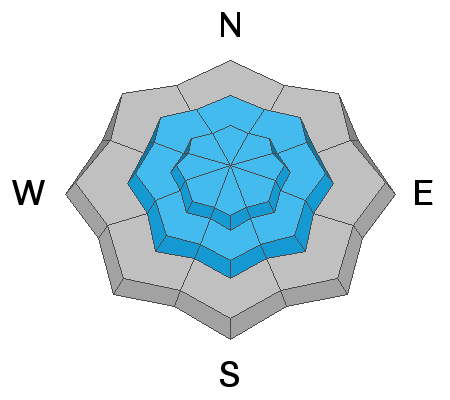Currently, skies are overcast and it has begun lightly snowing in the mountains. Mountain temperatures are in the low to mid-teens °F. Winds remain elevated from the Southwest blowing at speeds of 15-30 mph, with gusts up to 35 mph at mid-elevations. At upper elevation ridglines, the winds are howling, blowing at speeds of 40-50 mph, with gusts up above 80 mph. No new snowfall has begun accumulating yet this morning, but there is still soft settled powder in the mountains and riding conditions have greatly improved.
Before the break, yesterday's snowfall totals ended at:
Little Cottonwood Canyon: 18-23" (1.5-2.0 " H2O)
Big Cottonwood Canyon: 13-17" (1.24-1.41" H2O)
Park City Ridgeline: 7-13" (1.0-1.2" H2O)
Today, we can expect skies to remain overcast and temperatures to climb into the upper teens and low 20s°F. We should see periods of light snowfall this morning, and an increase in snowfall intensity this afternoon as a weak cold front pushes through the area. Throughout the day we could see another 5-9" of snow, before tapering off into light showers this evening. Winds will remain elevated and transition to more Westerly. At mid-elevations winds will average 15-25 mph, with gusts up to 35 mph. At upper-elevation ridgelines winds will blow 20-30 mph, with gusts up to 65 mph.
Yesterday was an active day both in the backcountry as well as ski resorts. Ski areas were reporting active results with explosives as well as some natural cycles during the peak of the storm, primarily in mid and upper elevation north facing terrain. In the backcountry, 10 new avalanches were reported. All of these avalanches were in the west to north to east facing mid and upper elevation terrain and triggered either within the new storm snow or down to the faceted snow as a soft slab. Many of these avalanches were remotely triggered from a distance.
Heat map of central Wasatch backcountry avalanche activity from yesterday.
One avalanche from yesterday, from the Park City Ridgeline in an area known as
Katie's, was remotely triggered from the Ridgeline and broke down 3' on facets sitting atop a crust. While the crown was primarily 3' deep, this area was heavily windloaded, and had crown depths up to 8'. This is a reminder that any slopes that area currently wind-loaded, are likely to break more deeply onto that weak faceted snow.
Photo showing the deepest part of the crown where the slope was heavily wind loaded. Katies, Park City Ridgeline, UT. (Z. Little)
You can find all backcountry observations
HERE. 












